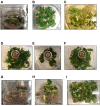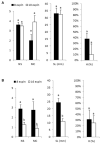A Temporary Immersion System to Improve Cannabis sativa Micropropagation
- PMID: 35812929
- PMCID: PMC9262383
- DOI: 10.3389/fpls.2022.895971
A Temporary Immersion System to Improve Cannabis sativa Micropropagation
Abstract
The aim of this study was to propagate axillary shoots of Cannabis sativa L. using liquid medium in temporary immersion bioreactors. The effect of immersion frequency (3 or 6 immersions per day), explant type (apical or basal sections), explant number (8, 10, and 16 explants), mineral medium (Murashige and Skoog half-strength nitrates, β-A and β-H, all supplemented with 2-μM metatopoline), sucrose supplementation (2, 0.5, and 0% sucrose), culture duration (4 and 6 weeks), and bioreactor type (RITA® and Plantform™) were investigated. As a result, we propose a protocol for the proliferation of cannabis apical segments in RITA® or Plantform™ bioreactors. The explants (8 per RITA® and 24 per Plantform™) are immersed for 1 min, 3 times per day in β-A medium supplemented with 2-μM metatopoline and 0.5% of sucrose and subcultured every 4 weeks. This is the first study using temporary immersion systems in C. sativa production, and our results provide new opportunities for the mass propagation of this species.
Keywords: Plantform™; RITA; bioreactors; liquid medium; mass propagation; sucrose.
Copyright © 2022 Rico, Garrido, Sánchez, Ferreiro-Vera, Codesido and Vidal.
Conflict of interest statement
JG, CF-V, and VC are employed by Phytoplant Research SLU. The remaining authors declare that the research was conducted in the absence of any commercial or financial relationships that could be construed as a potential conflict of interest.
Figures







Similar articles
-
Proliferation of Axillary Shoots of Chestnut in Temporary Immersion Systems.Methods Mol Biol. 2024;2759:167-181. doi: 10.1007/978-1-0716-3654-1_16. Methods Mol Biol. 2024. PMID: 38285149
-
Assessment of different temporary immersion systems in the micropropagation of anthurium (Anthurium andreanum).3 Biotech. 2019 Aug;9(8):307. doi: 10.1007/s13205-019-1833-2. Epub 2019 Jul 26. 3 Biotech. 2019. PMID: 31355116 Free PMC article.
-
In vitro multiplication and growth improvement of Olea europaea L. cv Canino with temporary immersion system (Plantform™).3 Biotech. 2018 Jul;8(7):317. doi: 10.1007/s13205-018-1346-4. Epub 2018 Jul 14. 3 Biotech. 2018. PMID: 30023149 Free PMC article.
-
Somatic embryogenesis of Arabica coffee in temporary immersion culture: Advances, limitations, and perspectives for mass propagation of selected genotypes.Front Plant Sci. 2022 Oct 6;13:994578. doi: 10.3389/fpls.2022.994578. eCollection 2022. Front Plant Sci. 2022. PMID: 36275513 Free PMC article.
-
Orchid Micropropagation Using Temporary Immersion Systems: A Review.Methods Mol Biol. 2024;2759:227-244. doi: 10.1007/978-1-0716-3654-1_21. Methods Mol Biol. 2024. PMID: 38285154 Review.
Cited by
-
Bioreactor systems for micropropagation of plants: present scenario and future prospects.Front Plant Sci. 2023 Apr 19;14:1159588. doi: 10.3389/fpls.2023.1159588. eCollection 2023. Front Plant Sci. 2023. PMID: 37152119 Free PMC article. Review.
-
The Effect of Silver Nanoparticle Addition on Micropropagation of Apricot Cultivars (Prunus armeniaca L.) in Semisolid and Liquid Media.Plants (Basel). 2023 Apr 3;12(7):1547. doi: 10.3390/plants12071547. Plants (Basel). 2023. PMID: 37050173 Free PMC article.
-
Bioreactor Systems to Mass-Produce the Undervalued Crop, Celosia argentea, With High Nutrient Impact.Eng Life Sci. 2025 Aug 13;25(8):e70038. doi: 10.1002/elsc.70038. eCollection 2025 Aug. Eng Life Sci. 2025. PMID: 40814569 Free PMC article.
-
Temporary Immersion Systems in Plant Micropropagation.Methods Mol Biol. 2024;2759:3-8. doi: 10.1007/978-1-0716-3654-1_1. Methods Mol Biol. 2024. PMID: 38285134
-
Challenges and potentials of new breeding techniques in Cannabis sativa.Front Plant Sci. 2023 Jun 8;14:1154332. doi: 10.3389/fpls.2023.1154332. eCollection 2023. Front Plant Sci. 2023. PMID: 37360738 Free PMC article. Review.
References
-
- Aitken-Christie J. (1991). Automation, in Micropropagation, eds Debergh P. C., Zimmerman R. H. (Dordrecht: Springer; ), 363–388. 10.1007/978-94-009-2075-0_23 - DOI
-
- Akdemir H., Süzerer V., Onay A., Tilkat E., Ersali Y., Çiftçi Y. O. (2014). Micropropagation of the pistachio and its rootstocks by temporary immersion system. Plant Cell. Tissue Organ Cult. 117, 65–76. 10.1007/s11240-013-0421-0 - DOI
-
- Akin M., Eyduran E., Reed B. M. (2017). Use of RSM and CHAID data mining algorithm for predicting mineral nutrition of hazelnut. Plant Cell Tissue Organ Cult. 128, 303–316. 10.1007/s11240-016-1110-6 - DOI
-
- Albarrán J., Bertrand B., Lartaud M., Etienne H. (2005). Cycle characteristics in a temporary immersion bioreactor affect regeneration, morphology, water and mineral status of coffee (Coffea arabica) somatic embryos. Plant Cell. Tissue Organ Cult. 81, 27–36. 10.1007/s11240-004-2618-8 - DOI
LinkOut - more resources
Full Text Sources
Research Materials

